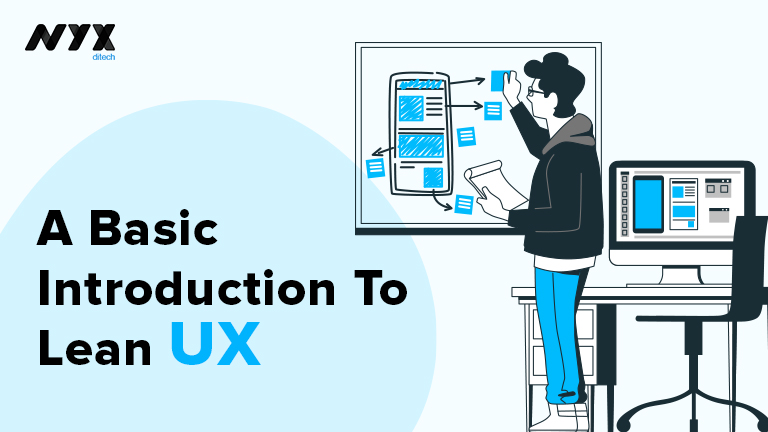A Basic Introduction To Lean UX

Lean UX has been debated and discussed in a variety of forums. Some have seen it as a condemnation of extensive documentation while others have said it’s a rebranding of techniques they’ve been practising for years. Lean UX is about bringing the true nature of a product to light faster, in a collaborative, cross-functional way that reduces the emphasis on thorough documentation while increasing the focus on building a shared understanding of the actual product experience being designed.
Lean UX is deeply collaborative and cross-functional because we no longer have the luxury of working in isolation from the rest of the product team. We can’t continue to ask our teams to wait for us to figure it all out. We need daily, continuous engagement with our teams if we are going to be effective. This continuous engagement allows us to strip away heavy deliverables in favor of techniques that allow us to build shared understanding with our teammates.
The Lean UX Cycle
The cycle contains three phases, and they are Thinking, Making, and Checking or Testing.
1. Thinking
Instead of exactly knowing what you would build, you start with something that might work, so, you build a hypothesis and then find the fastest way to validate that hypothesis.
In this phase, your team collaborate with different teams in the organization, this is not interrogative but a collaborative effort to generate more ideas or hypothesis to work on. This creates transparency between teams.
2. Making
After building the hypothesis, now you work on the way to validate it, and the best way to validate is to test it with the users of your product in real-time, but before that, we have to build something. This is where the concept of MVP(minimum viable product) comes into the picture. MVP is the smallest possible thing that we can build to help us to learn whether or not our hypothesis is true. That smallest thing could be wireframes, mockups, or working prototypes. The goal of MVP is to validate the hypothesis before committing a huge amount of resources to them.
3. Checking/Testing
In this phase, we test what we have built (our MVP) with users in real-time, we monitor them while they use our products and provide us with feedback. The goal of this phase to learn, whether a feature/product likely to succeed before you put resources to completely build it.
Key Facts About Lean UX
- Lean UX is an iterative process.
- It is a collaborative process.
- It is a user-centred process.
- It works on evidence, after each cycle, we pause and reflect.
- The goal is to make something in the fastest way possible, with minimum waste of resources, that users will use and buy.
Lean UX Is Not Lazy UX
It may seem at first that this is a lazy approach to UX, that the goal is simply to do less work. On the contrary, you’re actually using all of the tools in your UX toolkit. Sketching, presenting, critiquing, researching, testing, prototyping, even wireframing – these all get a solid workout in each cycle of the process. The trick is to use these tools when appropriate and, more importantly, to use them at the depth appropriate for the immediate problem you’re trying to solve for the business.
Reasons To Use Lean UX
1. Less Waste
Lean UX moves away from deliverables- (including flow diagrams, sitemaps, etc.) and documentation-based processes. Instead, it moves toward a more quality- and experience-centred practice. Why is this so significant? That’s because whatever is not used in developing the final product is considered wasteful and time-consuming.
2. Collaborative And Interdisciplinary
It intends to ‘‘foster more open, collaborative, and iterative processes, and to break through the organizational red tape that can stifle creativity’’. For example, a Lean UX team may consist of a handful number of experts depending on the nature of the project and the size of the organization from different fields/disciplines – such as creative director, designer and developer, allowing team-wide collaborations and feedback throughout the development process (the process also known as waterfall).
Just imagine how much time you can save through constant iterations and reviews! Collaborations in Lean UX is not only limited among the experts. Collaborations with customers are also placed at the heart of the practice, allowing us to have a shared understanding of problems and solutions with customers.
3. User Feedback Is Reflected At An Early Stage
Who has the final say in the final product? Without any doubt, it’s the customers. Whatever we design or develop, the successes are determined by whether the end-users will click the final version of the call-to-action button. By staying Lean, user feedback is reflected at an early stage of development, leading to the most desired results.
4. Fast And Efficient
Staying Lean highlights the shift of importance to ‘rapid experimentation and measurement’, helping us achieve the end result in a more efficient manner. The underlying assumption of Lean UX also enables the designers and developers to constantly adjust their plans to respond to the changing needs of the marketplace faster.
Wrap Up
This is a very high-level overview of Lean UX and, of course, there’s a lot more to it. However, these basic concepts should enable you to start heading in the right direction when it comes to implementing Lean UX in your Agile environment. In case you want to know more, feel free to discuss this with our team.
Read more about rules every UX designer should know here

